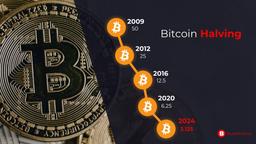What Is the Bitcoin Supply?
Have you ever mined for gold? The process of extracting the mineral from the ground is similar to mining for Bitcoin. Like gold, you cannot create Bitcoin on a whim. Instead, people have to solve complex computations to develop more BTC.
That said, there isn’t a limitless Bitcoin supply. On the contrary, the Bitcoin supply is limited. There have always been 21 million Bitcoins since its initial inception. According to the latest Bitcoin Total Supply Chart, roughly 18.76 million BTC have been mined thus far.
Why 21 million? What happens when it runs out? Today, we’re answering a few of these questions to help you understand how Bitcoin works and what’s behind its value.
The Facts Behind The Bitcoin Supply Limit
In 2009, a software developer working under the name of Satoshi Nakamoto released a program that created Bitcoin. At the time, it was the very first cryptocurrency, although there are now more than 10,000 different cryptocurrencies. Right from the beginning, the software’s source code mandated that there would be a limited supply of Bitcoins. Specifically, total production could not exceed 21 million.
This number was known as a “hard cap,” and since then, network nodes have continued to enforce it.
Why Was Bitcoin Capped?
What’s behind the hard cap, and why did the mysterious Nakamoto create it? The answer lies in the value proposition of the cryptocurrency.
As a general rule, the rarer an entity is, the more valuable it becomes. Eventually, it will become impossible to produce more Bitcoins, and that perceived scarcity will drive public interest. Again, think about it in terms of gold. It’s challenging to obtain more gold, which means that any gold you can acquire has that much more value. Nakamoto knew this, and it was a driving force behind the development of Bitcoin.
Without scarcity, Bitcoin becomes less attractive to would-be investors. But on the other hand, when investors know that they’re buying into a finite supply, they’re more confident that they’re making a wise decision for their financial future.
The Concept Of Bitcoin Halving

On average, around one new block of Bitcoin transactions is added to the total supply every 10 minutes. At that rate, we’ll reach that 21 million in no time. However, it slows down significantly over time thanks to a process known as Bitcoin halving.
When miners verify one block of transactions and add that block to the Bitcoin network, they earn a BTC reward. As mentioned, this process happens once every 10 minutes or so. Right now, each miner receives 6.25 Bitcoin per valid block they mine.
When four years pass or 210,000 blocks are mined (whichever happens first), this reward is reduced by half. To date, there have been three Bitcoin halving events.
When the cryptocurrency began, miners received 50 Bitcoin per block as a processing award.
The first halving event happened on November 28, 2012, and cut that reward to 25 Bitcoin. The second cut occurred on July 9, 2016, and took it to 12.5. Finally, the third and latest cut happened on May 11, 2020, which reduced it to 6.25.
What does this have to do with the Bitcoin supply? These miner rewards are what generate new Bitcoin into circulation. As this number continues to lower, the rate at which we’re nearing 21 million will slow significantly.
Can The Hard Cap Change?
According to some analysts, Bitcoin is purely software at its core. Knowing this, it should be possible to change its rules and codes with a few clicks. These critics argue that Bitcoin miners will eventually seek to extend the 21 million Bitcoin limit. After all, these miners must spend their time, energy, and computing power to produce new Bitcoin, and they earn their reward when they manage to do so. So to keep their revenue stream healthy, it’s anticipated that they’ll push for the ability to keep Bitcoin mining, even when they reach the hard cap limit. If they manage, they can produce an infinite number of Bitcoin. It’s a proposition that sounds intriguing, but there are a few different reasons why this will likely never happen.
Let’s look at the ironclad factors holding the hard cap.
The Scarcity Incentive
Changing the limit on Bitcoin may benefit miners in the short term. In many ways, it would be like giving someone the key to the U.S. Mint and allowing them to print money until they got caught. However, a more thorough examination reveals that this would actually hurt miners in the long run. Remember that Bitcoin is valuable and intriguing to high-profile investors chiefly because it’s scarce. This truth accounts for much of its growing value and is the factor that gives them faith in the network.
As such, removing this factor could eventually cause Bitcoin to lose its perceived value, which would cause prices to collapse. At that point, it wouldn’t matter how much Bitcoin a miner possessed, as their investment would be worth less. In fiat terms, all of those veritable “dollars” they just printed would be more like pennies.
After all, fiat revenue is just as relevant to miners as Bitcoin revenue. While some stores have started accepting Bitcoin as a form of payment, most miners still pay for most of their costs in fiat. Therefore, the currency is only valuable if Bitcoin prices can convert highly into U.S. dollars.
Rules Of The Distributed Network
Second, Bitcoin’s hard cap cannot be changed because the network is lock-tight. So, yes, this is a consensus-based network without central governance, but that doesn’t mean it’s a free-for-all.
For one, there isn’t a single, universal version of the Bitcoin source code that everyone has access to all the time. Instead, there are hundreds of different versions, each with its own associated network nodes. Today, most of these nodes operate under Bitcoin Core. However, this is only the case for some of them. Some are still running older or different versions. This means that while some miners might find a way to change one version of the Bitcoin source code, they won’t make a widespread difference.
To truly adjust the network, they would have to coordinate and sync tens of thousands of network nodes, which is virtually impossible. Moreover, this assumes that miners even have that much autonomy in the first place.
In reality, miners are only responsible for mining new blocks and validating transactions. Each time a miner adds a new block to the network, those nodes activate and start verifying it, each one working independently of the other.
As they work, they make sure that the transaction meets the following conditions:
- The block produces the right amount of new Bitcoins
- There’s a valid Proof-of-Work included for the transaction
- All transactions related to the block are verifiable
If any block violates these rules, the nodes will reject it. As such, the nodes have true control over Bitcoin governance, not the miners themselves. Even if they wanted to mine more than 21 million Bitcoin, they would not be able to make the back-end changes required.
Possible Changes For The Future

While it would be difficult for developers or miners to remove the Bitcoin hard cap on their own, it’s not theoretically impossible. However, it would need to be more of a concerted effort rather than a one-off approach. If developers worked collaboratively to write a new source code that would remove the 21 million limit, they would have to propose it to the cryptocurrency development community first.
As you might imagine, these discussions will not be quick, nor will they be consensual. However, if, for some reason, the community did agree on the change, then it would likely start at Bitcoin Core. Instead of just implementing the new rules immediately, there would also need to be an agreed-upon activation path. Making these changes would require a process called a “hard fork,” which requires every node on the network to participate. Any non-adopters would then be forced to leave the Bitcoin network.
Once an activation path was created and most of the network backed it, it would activate. Even then, there may be network nodes and individual miners who do not support the change. If this happens, most of the network backed it, those outliers would remain on the original Bitcoin network, and both networks would compete for overall market share.
Get Your Share Of The Bitcoin Market
Despite all of the new types of cryptocurrency developed lately, Bitcoin remains the most popular and profitable. So if you’re considering investing, it helps to know the processes behind its development-including learning about the Bitcoin supply and why it’s such an essential factor in the currency’s value proposition.
As we inch closer to that looming 21 million finish line, there’s still plenty of time to cash in on this growing market. Along the way, we’re here to help answer any questions you might have. We can also point you toward the closest Bitcoin ATM so you can get started immediately. Feel free to explore the rest of our news and advice, and reach out to our team if you need assistance.



